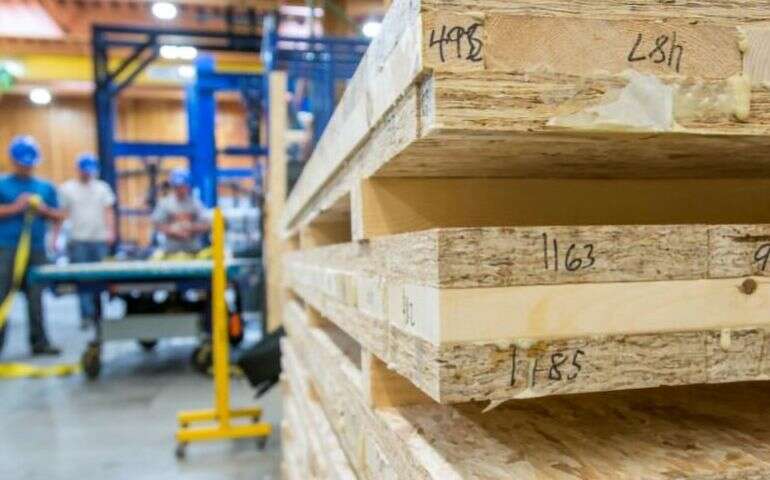
Fed funds will go to UMaine wind energy, mass timber programs
 COURTESY / MAINE AQUA VENTUS
The Senate Appropriations Committee approved a bill that includes funds to advance the University of Maine’s offshore wind energy demonstration project, Aqua Ventus. Here, a worker at Cianbro's Brewer facility checks on a prototype offshore wind platform.
COURTESY / MAINE AQUA VENTUS
The Senate Appropriations Committee approved a bill that includes funds to advance the University of Maine’s offshore wind energy demonstration project, Aqua Ventus. Here, a worker at Cianbro's Brewer facility checks on a prototype offshore wind platform.
The U.S. Senate Appropriations Committee has approved an energy and water funding bill that includes support for several research and development projects at the University of Maine.
The bill is expected to provide funding for UMaine’s offshore wind energy demonstration project, Aqua Ventus, according to a news release from the office of U.S. Sen. Susan Collins, R-Maine. Also included is support for a program to create energy-efficient, high-rise mass timber building systems.
Collins is a senior member of the Appropriations Committee, which advanced the fiscal year 2020 funding bill yesterday.
Wind
As one of UMaine’s signature projects, New England Aqua Ventus I may soon be the first floating, deepwater offshore wind turbines in the United States. Aqua Ventus is one of two offshore wind demonstration projects included under a $10 million provision for large turbines. The bill also includes $4 million for manufacturing large wind blades. Part of the manufacturing process is expected to utilize UMaine’s new 3D printer, to produce portions of the blades and their molds.
In June, Gov. Janet Mills signed into law an offshore wind-power development bill that required Maine's Public Utilities Commission to approve the contract for the Aqua Ventus project. In the pilot, supported by $39.9 million in grant money from the U.S. Department of Energy, the turbines are to be assembled in Maine and floated off the coast, where they will provide clean energy for the state.
"This is outstanding news for renewable ocean energy research and development for Maine and for the country,” Habib Dagher, executive director of UMaine’s Advanced Structures and Composites Center, said in the release.
“This funding will ensure that Maine and the U.S. will continue to lead in developing offshore wind technology, mitigate climate change and create thousands of green energy jobs. Harnessing just 3% of the Gulf of Maine offshore wind resource is enough to heat every home in Maine and convert every car into electricity, allowing us to keep more than $3 billion per year in Maine.”
Wood
The bill includes $5 million for the Maine Mass Timber Commercialization Center, UMaine’s program to research and produce mass timber, or cross-laminated timber, which can be used for the construction of tall wood buildings. The center's aim is to be a resource where forest industry partners, construction firms and other stakeholders can collaborate and advance new forest product technologies in Maine.

In August, UMaine and Bowdoin College were among 10 institutions that received $100,000 each from the U.S. Forest Service to research and construct mass timber buildings on college campuses.
“This legislation supports the students and scientists at UMaine who are discovering environmentally-friendly and cost-effective ways to power our homes, expand the use of wood products and construct energy efficient buildings,” Collins said in the release.
3D printing
The bill also includes $20 million for the development of additive manufacturing that involves nano-cellulose feedstock materials, which are made from forest products. The money will support UMaine’s research collaboration with the U.S. Department of Energy’s Oak Ridge National Laboratory to advance efforts to 3D printing with wood products.
"It will allow us to use wood in large-scale 3D printing, creating new opportunities for the wood products industry,” Dagher said.
A goal is to develop materials that can print using cellulose and nanocellulose derived from Maine’s wood resource, he added.
The University of Maine and Oak Ridge National Laboratory announced their research collaboration in May.
The $20 million initiative is seen as a promising new technology with strong potential to create a new market for Maine’s $8.5 billion forest products industry. The Oak Ridge and UMaine research team will work with the forest products industry to produce new bio-based materials that will be conducive to 3D printing a variety of projects including boat hull molds, shelters, building components, tooling for composites and wind blades.













0 Comments